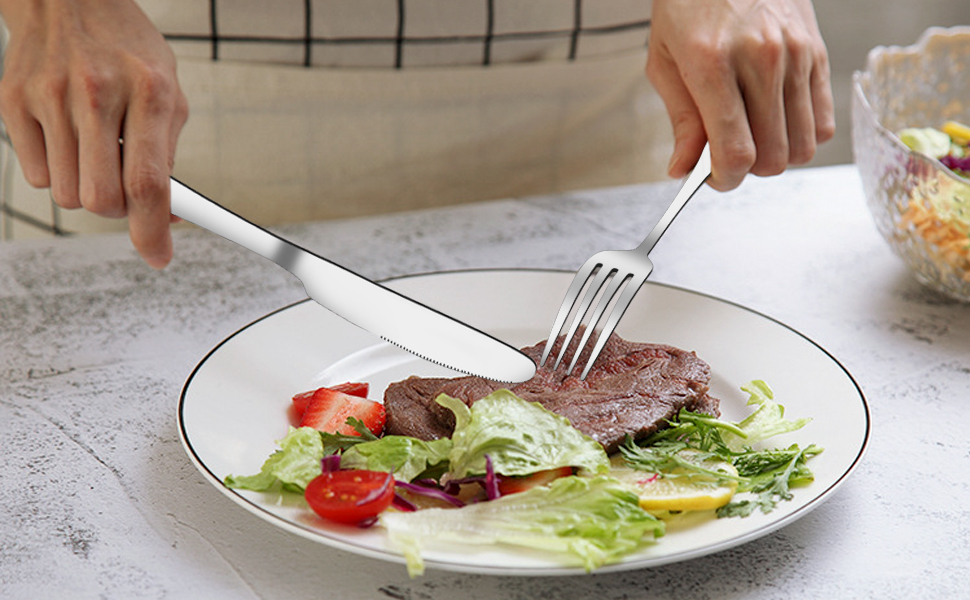In the culinary world, especially among kitchen professionals, understanding the nuances of knife etiquette with prime rib is essential. This isn't just about slicing meat; it's about presentation, technique, and respect for the culinary arts. The prime rib, a cut adored for its flavor and tenderness, demands a particular set of skills and etiquette when it comes time to serve.
For those working in professional kitchens, the art of carving and serving prime rib can elevate a dining experience from ordinary to extraordinary. Whether you're a seasoned chef or a budding cook, mastering the etiquette involved in properly handling knives with this exquisite cut of meat is crucial.

Understanding Prime Rib
The prime rib, also known as a standing rib roast, is a cut of beef from the primal rib, one of the nine primal cuts of beef. Renowned for its rich flavor and juicy tenderness, this cut is often the centerpiece of festive meals and special occasions. To do justice to such a premium cut, understanding the proper knife etiquette is vital.
For more insights into the intricacies of prime rib, including the best practices for preparation and serving, you might find this guide on cutlery helpful.
The Right Tools for the Job
Before diving into the techniques, ensuring you have the right tools is imperative. A German slicing knife is often recommended due to its sharp and durable blade, perfect for cutting through the prime rib without tearing.
To understand why German knives are preferred, you can explore this article on German slicing knives for more detailed information.
Choosing the Ideal Knife
When selecting a knife for carving prime rib, consider the following features:
- Blade Sharpness: A sharp blade is essential for clean cuts.
- Blade Length: A longer blade provides better control over larger cuts of meat.
- Grip and Balance: Ensure the knife feels comfortable in your hand and is well-balanced.
For more on the materials and craftsmanship of German knives, visit this resource on knife materials.
Mastering the Technique
Once you've chosen the right knife, it's time to hone your technique. Carving prime rib requires patience and precision. Begin by positioning the rib on a stable cutting board, ensuring that it doesn't slip as you carve.
Steps for Carving Prime Rib
Follow these steps to achieve perfectly sliced prime rib:
- Rest the Meat: Allow the prime rib to rest after cooking, which helps retain its juices.
- Locate the Bone: If serving bone-in rib, start by slicing along the bone to separate the meat.
- Slice Against the Grain: Always cut against the grain to ensure tender slices.
- Consistent Thickness: Aim for uniform slices for an aesthetically pleasing presentation.
For more on how to hold a knife and fork when dining, this guide on holding cutlery can be helpful.
The Importance of Presentation
In a professional kitchen, the presentation is as important as the taste. Carefully arranged slices of prime rib, with the right garnish, can elevate the dining experience. Remember, the first bite is with the eyes.
For a deeper dive into formal dining etiquette, this guide on table manners offers additional insights.
Conclusion
Understanding knife etiquette with prime rib is about more than just cutting meat. It's about respecting the culinary process and providing an exceptional dining experience. With the right tools, technique, and a touch of presentation, you can master this essential skill in any professional kitchen.

FAQ
What is the best knife for carving prime rib?
A sharp, well-balanced German slicing knife is ideal for carving prime rib, offering precision and durability.
How do I ensure my prime rib is tender?
Always allow the meat to rest after cooking, and slice against the grain to ensure tenderness.
Why is presentation important in carving prime rib?
Presentation enhances the dining experience and showcases the skill of the chef, making the dish more appealing to diners.
This article contains affiliate links. We may earn a commission at no extra cost to you.


























